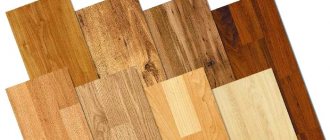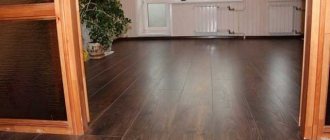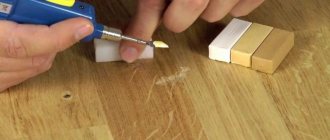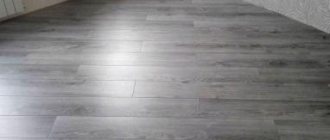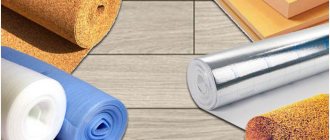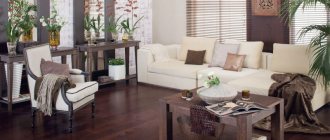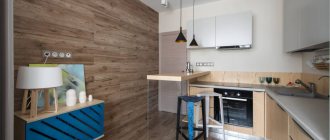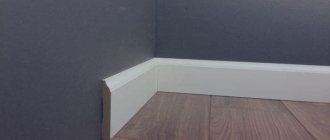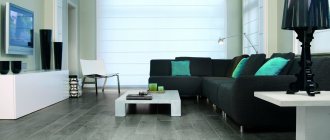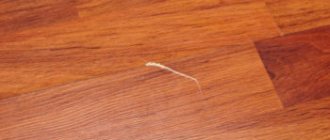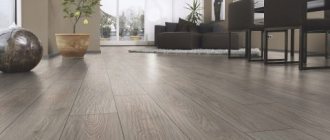When deciding on the flooring for an apartment, many have difficulty choosing between parquet and laminate. Parquet used to be in almost every standard apartment, and as soon as laminate boards appeared - a beautiful, fashionable and attractive coating - many appreciated its aesthetic appearance, ease of installation and resistance to external influences.
Over time, many have come to appreciate the good old parquet flooring more - for the fact that it is still a natural material that can be repaired and restored, as a result of which it acquires a quite presentable appearance, while being environmentally friendly and safe for health. New types of parquet have also appeared, and laminate has become even more reliable. How can you not get confused when choosing. Let's look at all the advantages and disadvantages of these two popular materials.
The principle of laminate construction
The very name of this type of coating comes from the structural features. The term translates as “multilayer coating”. It is the structure that provides the features of this type of coating, which include both pros and cons.
The main difference between laminate and parquet boards is its design. The stabilizing layer of the laminate is chipboard (fibreboard). It is responsible for the fireproof properties of the laminate. Under the chipboard there is a layer of plastic or paper impregnated with resinous substances, which guarantees the material protection from moisture. Treating all edges with a wax-containing impregnation also protects the boards from moisture.
The top layer is decorative, made of paper. It is he who is responsible for the attractiveness of the coating. It can be very different - wood, with a tile pattern, stone, with any fashionable texture.
A high-quality print allows you to accurately convey the texture, which makes the coating very similar to natural. The top layer is coated with melamine resin, which gives it strength, reliably retains color and protects it from external influences. It does not fade, does not lose brightness, does not scratch, does not get wet.
Advantages and disadvantages of laminate
There is an opinion that laminate is fragile, quickly breaks down and loses its appearance. However, this is not so - the strength of the laminate depends on its class, and the class, in turn, is selected depending on the planned use. It is hardly worth paying extra money to get a floor in the nursery that is stronger than street tiles, where many people pass during the day. In the same way, you should not skimp on the wear resistance of the flooring in the kitchen or living room, where there are always a lot of people or which is actively and frequently used.
If someone decided to save money and chose a weak type of laminate, but it quickly wore out due to excessive load, this is a mistake in selecting the right class of material. Laminate is divided into strength classes: durable and moderate strength. Durable - these are classes 31, 32, 33, the so-called commercial ones. They are used for offices, industrial premises, public places or for the most actively visited areas of the house. It looks reliable, lasts a long time and is not easily damaged.
For an office, bedroom or nursery, you can choose classes with less strength, 21, 22 and 23.
Strengths of laminate:
- It is easy to care for, it always looks good and does not attract dust.
- It is abrasion resistant, not easy to scratch, and can withstand impacts. The higher the class, the higher the resistance of the laminate to mechanical stress.
- It is resistant to compression.
- It is resistant to fading, retains color for a long time, and does not come into contact with chemicals during cleaning.
- It is suitable for organizing heated floors.
- It’s not difficult to choose the right shade, pattern, texture – the choice is huge.
- It installs quickly and easily. Installation can be done even by non-professionals.
Weaknesses of laminate:
- Does not tolerate high humidity well: it can quickly lose its properties.
- Not for outdoor use.
- Requires additional sound insulation during installation.
- Cannot be repaired, only replaced.
- From the outside it is clear that the material is artificial.
As you can see, the material is durable, reliable, lasts a long time (by the way, it has a 5-year guarantee), it is easy to handle, there is no fear that it can be damaged, rather, on the contrary - it is quite difficult. The only thing that needs to be taken into account is that it is advisable to lay down sound insulation during installation and it is better to choose a distinctly artificial pattern so that the effect of an unsuccessful fake is not obtained. You should also avoid using such a coating in rooms with high humidity, otherwise the structure will dry out and lose its strength and stability, but in such rooms it is already common to use tiles.
From the point of view of the purpose of the room
Laminate will last longer in rooms with high traffic, high humidity and possible dirt. Laminate also differs from parquet boards in its compatibility with “warm floor” systems. Parquet itself is a warm material, which also does not conduct heat well.
Elegant-looking parquet will look good in offices, living rooms, libraries and halls of private homes.
Hardness and load bearing capacity
Due to the fact that the parquet is made of natural wood, which has soft pine bars in the middle, it is able to withstand greater loads than class “33” laminate.
Tactile sensations and heat loss
Of course, parquet is more pleasant if you walk on the floor barefoot. Wood has lower thermal conductivity and therefore remains warm longer in cold weather. For this reason, it is better to choose parquet for a bedroom or children's room.
Environmental friendliness
From the point of view of environmentalists, parquet boards are positively different. And although adhesives are used in its production to hold the layers together, laminate still has both a glue base and protective finishing coatings made of melamine or acrylic.
Soundproofing characteristics
The noise level of both materials is approximately the same, but the sound of parquet is still duller. However, if the issue of soundproofing the floor is acute, then for this purpose you can lay a substrate under the laminate, which will prevent the effect of “walking on your neighbors’ heads.”
Moisture and temperature resistance
Acrylic and melamine coatings guarantee greater protection against temperature changes, humidity and even liquid spills on the floor than oil or a thin surface layer of varnish on parquet.
Laminate flooring is more resistant to moisture than parquet
Durability of the coating and possibility of restoration
In the question of what is better than a good laminate or parquet board in terms of durability, there are some points that make it difficult to give a definite answer. Dense and hard MDF slats with a protective coating will last longer and resist damage. At the same time, the parquet can be scraped off and re-coated with varnish or oil, thus doubling or even tripling its service life, while its counterpart will have to be completely re-laid.
Appearance
If you do not consider particularly luxurious varieties of parquet, it is difficult to determine at a glance what exactly has been laid: parquet or laminate - the difference is small. Although if you start to look closely, the parquet still looks more noble.
Flooring installation
Installation is radically different - laminate is laid using the floating method on the substrate, while parquet requires special glue for fastening to the floor, and also requires hardware, clamps and special fastening cords.
Care
To maintain cleanliness, both coatings require only wiping with a damp cloth, and the use of aggressive detergents should be avoided.
Why choose parquet boards?
It is generally accepted that parquet is a natural covering and this is its main difference from laminate. However, the main difference is different, and such a statement is not entirely true.
The peculiarity of parquet boards is its structure. The part that we see usually consists of valuable wood. This is a thin layer ranging from just over two to six millimeters thick. It is covered with a protective layer - a special varnish that protects the wood from various influences.
Under the layer of wood there are narrow dies - lamellas - which make up the main, central layer of the parquet board. They are located perpendicular to the board and have a fastening for connection with the adjacent board. The bottom layer is natural plywood about 2 mm thick.
When asked why parquet is chosen, I would like to remind you, first of all, that laminate was created as a more budget-friendly substitute for parquet. Parquet boards are chosen for the beauty of their natural pattern, durability, and almost endless service life. Not for environmental friendliness, as some people think. Laminate can also be made from natural ingredients. But laminate cannot be restored, while parquet boards can be sanded, which allows you to completely renew its outer layer.
For more information about the difference between parquet and laminate, watch the video:
The main thing why people love parquet is its good appearance - an indicator of prosperity, self-respect, and naturalness.
Differences between laminate and parquet
Having assessed the characteristics of the three materials listed above, it becomes clear that they all have significant differences from each other:
- Durable, moisture-resistant, easy to install and maintain, laminate can imitate parquet and parquet boards, but it lacks the main quality of natural wood - heat capacity. However, a wide range of colors and imitations of natural materials allows us to call this material universal. Another advantage is that laminate can be laid not only on the floor, but also on walls and ceilings.
- Parquet boards can be considered the “golden mean” between multilayer laminate and expensive solid wood in the form of single-layer parquet strips. This material has the easy installation characteristic of laminate, but it is more demanding in terms of care and operating conditions, since it consists of natural wood.
- Parquet flooring has long established itself as a durable, beautiful, environmentally friendly material for floor finishing. It is reliable and functional, but has the highest cost.
Laying parquet in a herringbone pattern
The main differences between these materials can be seen when assessing the main characteristics.
Table 1. Main differences
| Parameter | Parquet | Parquet board | Laminate |
| Illustration | |||
| Appearance | It is characterized by warm, natural shades, unique textures and patterns of each die with a natural surface pleasant to the touch. | The front natural wood layer does not have a variety of textures. The surface is pleasant and warm to the touch. | The widest range of simulated materials - natural wood, parquet, tiles, stone and others. |
| Service life and wear resistance | These indicators depend not only on the type of wood, but also on the thickness of the protective varnish layer, which can ensure a parquet service life of up to 50 years. | When the surface of a board is treated with varnish, its service life is 30 years, and impregnation with oil and wax guarantees the service life of the coating for no more than 10 years. | The service life of a laminate depends on its class; the higher it is, the more durable it is. |
| Possibility of use in the “warm floor” system | Water | Water, infrared | Water, infrared |
| Maintainability | Can be restored (up to 12 times) | Can be restored (up to 4 times) | If the lamellas are damaged they must be replaced |
| Moisture resistance | When treated with special impregnations and varnish | When treated with special impregnations and varnish | Depending on the thickness of the front layer and the addition of polymers to the base composition |
| Care requirements | Surfaces treated with oil and wax require special care. And the varnish coating is resistant to moisture and less demanding. | The coating is difficult to maintain and requires constant care using special chemicals. | Easy to care for. |
Pros and cons of parquet
Like any covering, parquet has its advantages and disadvantages.
Let's start with the pros:
- Made from natural wood, the coating reliably protects against external noise.
- Parquet boards do not attract dust.
- The coating is harmless. The coating with a special varnish without toxic formaldehyde, produced under industrial conditions, is very durable and at the same time safe.
- The possibility of endless restoration makes the coating eternal.
- The natural look of parquet flooring cannot be replaced by anything.
- Caring for parquet boards is quite simple.
- A variety of ways to lay modern parquet.
- Long service life. Manufacturers provide a guarantee of up to 10 years.
As you can see, the main advantages of parquet boards are strength, indestructibility and aesthetics. However, it is important to pay attention to the fact that restoring a parquet board is labor-intensive; the thicker the board, the more times it can be restored; restoration can cost as much as buying laminate, which is more wear-resistant, so the desire to have a natural coating with a natural wood pattern usually wins , a longer natural service life and the realization that the floor in the apartment is covered with a layer of real wood, which has its own unique energy.
And the variety of sizes, installation methods, coating colors, and parquet allows you to get an ultra-modern solution from old parquet, and find very original solutions among new products.
Natural wood is not always the strongest material. For the outer layer of parquet, they usually use such durable and noble species as oak - the leader in strength, beech - light and delicate, therefore a favorite material for children's rooms, cherry - rich in shades, walnut - wear-resistant and unpretentious, maple - less elite, but quite durable . For the bottom layer, pine or spruce is usually used - natural, warm, but vulnerable to abrasion. If you use pine as the outer layer, the floor will be beautiful, natural, but will wear out faster. There are a number of features regarding larch - such features of wood as a tendency to cracks and porosity can turn out to be both a plus and a minus.
Disadvantages of parquet boards:
- Parquet boards do not like moisture, so they are not suitable for rooms with high humidity.
- Parquet varnish wears off over time and requires restoration.
- The service life and type of parquet are influenced by the indoor climate.
- Parquet boards on warm floors require a number of precautions.
Unlike laminate, parquet boards are recommended for heated floors with a number of precautions, but a lot depends on the quality of the parquet. Typically, when making parquet, harmful compounds are not used, especially those that exhibit negative properties when heated. For the decorative layer, use well-dried high-quality wood, otherwise cracks will appear. If these conditions are met and fire safety measures are met, you can install parquet flooring on the heated floor system. However, during operation it is important to comply with several requirements: keep the temperature uniform, avoid too high heating, temperature changes, frequent heating on and off, do not lay carpets on a floor with parquet on a warm floor. Then the parquet flooring will last a long time and look great.
Which flooring is better to choose for an apartment?
After comparing the main characteristics, pros and cons of the presented floor coverings, it’s time to make the final decision: whether to choose laminate or parquet boards.
The choice is really difficult. Everyone focuses not only on quality, but also on their financial capabilities. When compared by price, laminate undoubtedly wins here.
Even an expensive waterproof laminate flooring from a well-known brand with guarantees of quality and a long service life will cost much less than piece parquet or parquet boards.
But if finances allow, then it makes sense to make the final decision in favor of expensive, but more prestigious parquet. Piece parquet, laid in the form of a patterned covering, will look great both in a luxurious house and in an apartment. And its durability and environmental friendliness will not raise any doubts.
A parquet board would also be a good option. It is cheaper than piece parquet and solid wood boards, but has good load resistance properties.
The main advantage of parquet has always been its natural component. But if you look at it, both laminate and parquet boards are made of wood. This only means that both materials are environmentally friendly. At the same time, both parquet and high-quality laminate have the same emission class (emission of phenol-formaldehyde vapors into the surrounding space) - E1.
In the production of laminate, HDF panels with formaldehyde impregnation are used to acquire water-repellent and antibacterial properties. Currently, 99% of laminates are labeled E1.
The release of harmful substances from natural coniferous wood without any preservatives, impregnations or other additives also corresponds to emission class E1. Therefore, the question of the environmental friendliness of both materials can be considered settled.
There is an opinion that laminate flooring produces creaks and hums, unlike parquet. It is worth noting that this depends only on the correct installation, the quality of the substrate and the leveling of the base. In both cases, high-quality installation and a cork backing will help achieve ideal sound insulation.
If we compare both coatings regarding the possibility of restoration and repair, then there are nuances here too. Parquet boards can be sanded, but this can not be done very often and only 2-3 times during the entire period of operation. During the sanding process, toning and brushing are removed, which changes the original appearance, and the board can sag and deform.
Laminate cannot be sanded, but in case of minor damage, you can use cosmetic methods and mask scratches and cracks with putty, or completely replace the damaged panel.
The floor covering is not chosen for a month or a year, so you need to approach the problem of choice with all responsibility. We should also not forget about the aesthetic component, which lies in the correspondence of the selected material to the overall interior design.
Parquet or laminate, which is better for the floor?
Today, new residents and people planning to renovate their premises have a wide choice of finishing materials. The main differences and criteria for choosing any group of materials are cost, practicality, ease of maintenance, durability and image component.
If from this point of view we consider the materials used for finishing the floor, then first of all we remember the two most popular varieties in our homes: parquet and laminate.
On the one hand, these options have a lot in common: both create the look of wooden floors, both require fairly careful operation, and both are available on the market in a variety of structures and shades. But there are also many differences, which are the main criteria for choosing. Among them are the economic component, the factor of naturalness and the durability of such a coating.
The most obvious advantage of laminate is its affordable cost. Both the laminated panels themselves and the installation work will cost much less than parquet. At the same time, the range of laminate flooring is much wider, even compared to modern parquet.
A wide selection of colors, shades, textures can satisfy any designer's whim. Laminate can imitate both wood and marble, natural stone, and tiles.
The durability and resistance to damage of modern laminate can be called its main consumer characteristic. It adequately withstands walking in shoes with heels, pet claws, dropped dishes, and liquid ingress. There are classes of laminate that are designed for increased loads and are intended for use in office premises.
The disadvantage of floors made from laminated panels is that they are not entirely of natural origin. Although the base of laminate flooring is made from multi-layer laminated wood (HDF), its outer layer is covered with a layer of cellulose, specially treated with artificial resin, which creates a wear-resistant floor surface.
All layers are firmly bonded to each other using resin, high temperature and pressure using Direct Pressure Laminate technology.
Parquet is a more expensive and “capricious” type of flooring. The cheapest parquet board is made from tree species growing in our forest belt. Oak and beech are the most accessible and widespread species. If the wood is thinner and more difficult to process, such as cherry, walnut, birch, then the price increases.
Parquet is more susceptible to wear and mechanical damage, but unlike laminate, it can be restored. With the help of special varnishes and oils, simple oak parquet can be given different shades (merbau, cherry, walnut, mahogany, white, red, stained) and radically update your floor. If you treat parquet regularly, every 7-8 years, it will last 4-5 such cycles.
Today, consumers have increased demand for rare and exotic types of parquet, and manufacturers are trying to satisfy customers by offering parquet boards made from exotic trees such as merbau, bamboo, wenge, jatoba, rosewood, and olive wood.
However, when choosing such parquet, you should pay attention to the climate of the area native to these species. Not all of them can comfortably “take root” in our climatic conditions and, accordingly, require special care and care.
Of course, the main advantage of parquet is its natural origin, which creates a special favorable atmosphere in the house. With proper installation, parquet fragments can be used to create a unique pattern, which will certainly appeal to fans of original design.
Also, professional work on laying parquet floors is the key to its “silence” - the parquet does not creak or sag, which often happens with laminate flooring.
Parquet board quality rating
In the parquet board market, both European manufacturers are popular: Ecowood, Solidfloor, Woodbee, Weidzer, Meister, as well as Russian and Ukrainian parquet: InexUkrParquet, Kern, Taiga, Karelia. The range in cost in this segment is very large.
- Kahrs
To produce parquet flooring, this company uses the best materials: oak, beech, solid ash, birch and poplar, cherry, maple, walnut and its close relative hickory, as well as exotic woods like yarra and copal wood.
Karhs products are impeccable and have already earned many awards - all thanks to the latest solid wood processing technologies that eliminate manufacturing defects. By design, the boards are divided into one-, two- and three-strip, deck lamellas, as well as models with a Danish pattern.
- Pros:
- There are currently 34 collections on the market;
- wide range of natural colors;
- products are created from environmentally friendly wood species;
- Some collections come with Woodlock locks that simplify installation;
- Wear-resistant satin varnish is used for the finishing coating;
- you can buy parquet with non-toxic oil impregnation;
- a wide range of prices - there are boards for every taste and budget;
- 12 years warranty for budget coatings with a thickness of 7 mm and 30 years for 15 mm;
- It is possible to order parquet individually.
- Minuses:
- Some models may not be available in stores;
- even economy class slats are expensive.
- Haro
A German company that has grown over 150 years from a small family sawmill into the third largest manufacturer of flooring in the world. In its work, the company uses popular and very beautiful types of wood: oak, maple, beech, ash, solid American cherry and white acacia. This is one of the few manufacturers that combines ancient woodworking customs and modern technologies.
- Pros:
- the widest range - more than 200 types of parquet boards;
- There are premium series, completely made by hand;
- slats for the blind – with raised indicators;
- The range even includes moisture-resistant boards for bathrooms;
- durable and non-toxic varnish coating with UV filters;
- Additional components are produced for each collection (plinths, thresholds);
- All boards come with locking joints.
- Minuses:
- high price;
- Most types of parquet boards are delivered only to order.
- Magnum
This Czech company was initially focused on producing budget parquet boards. It may seem that economy-class flooring is not capable of lasting long, but in terms of strength and wear resistance, Magnum products quite successfully compete with famous brands.
It is not for nothing that the manufacturer has raised the warranty period of its products to 25 years. The Czechs managed to achieve this after completely modernizing their equipment and introducing the latest wood processing technologies.
- Pros:
- excellent quality parquet boards at an affordable price;
- the wood is stabilized by steam under pressure;
- About 30 different types of trees are used to produce parquet;
- the finished coating looks good and expensive;
- simple installation system that does not require special professionalism;
- the boards come with a 5-layer varnish coating;
- parquet tolerates contact with water quite well;
- Freely sold in stores - no need to wait long for your order.
- Minuses:
- there are few two-strip lamellas in the assortment;
- standardized size range - only panels 2200x205 mm.
- Tarkett Sinteros
A Swedish brand that produces finishing materials jointly with Russia and Serbia, and in some ways a trendsetter in parquet fashion. The company produces a huge number of coatings under two brands - Tarkett itself and Sinteros.
The first is focused on the production of high-end products (perhaps this is the case in Europe). Alas, these boards do not come to us in the best condition and have already earned a bad reputation among buyers.
But Sinteros, despite its belonging to the budget category, turned out to be really very worthy. And although its range is not rich, these products are of high quality. In total, under the Tarkett Sinteros brand, 25 models of parquet are produced from 5 types of wood: ash, oak, merbau, beech and kempas.
- Pros:
- the slats are coated with a non-toxic but very durable water-based varnish;
- boards with T-lock locks can be laid in different ways;
- several standard sizes of planks;
- There are suitable skirting boards for each type of parquet;
- available in many stores in Russia;
- the complaint service helps solve problems with returns and replacements;
- the price is slightly higher than laminate.
- Minuses:
- Occasionally you come across a defective board.
- Upofloor
A very popular Russian-Finnish project among us. The plant in Karelia 5 years ago came under the control of the Swedish company Kahrs, thanks to which the already good quality of its products continues to improve.
Only environmentally friendly timber from birch, merbau, beech, ash, walnut and oak is used in production. The design of parquet boards is one-, two- or three-strip, and the finishing is carried out using oils or matte varnish. Upoflor already has many awards and positive reviews.
- Pros:
- large assortment - 5 collections and more than 70 design options;
- timber undergoes environmentally friendly processing (brushing, staining, steaming);
- All boards come with tongues for easy floating installation;
- good selection of standard sizes;
- the declared service life of parquet is 20 years;
- affordable prices.
- Minuses:
- sometimes problems with the geometry of individual lamellas are identified;
- Over time, birch boards are dented by heavy furniture.
Service life of parquet boards at home
Product service life is one of the most important criteria, based on which buyers make their choice. Parquet boards, which have become one of the most popular types of flooring, also have their own limitations on service life.
Such terms vary significantly, depending on the type of board itself and the conditions in which it is used. Also, the length of the service period is directly affected by the regularity and quality of floor care.
The service life range for parquet slab flooring ranges from 10-20 years.
- Atmospheric factors have a great influence on the duration of preservation of the technical characteristics and external presentability of the parquet board:
- temperature regime;
- humidity level.
The optimal temperature for such a floor covering is 20-24 degrees, with indoor air humidity 45-60%. If the specified climatic conditions are not observed, the surface of the board begins to quickly deteriorate, which manifests itself in the form of cracks, swelling of the upper layers of the board and other visible deformations.
In order not to harm the parquet flooring and thereby increase its service life, cleaning should be done using a vacuum cleaner and a thoroughly wrung-out cloth. For wet cleaning, you should use special concentrated products that contain ingredients that are safe for parquet surfaces.
Another important factor influencing the durability of a floor surface made with parquet boards is the technology and quality of installation. Thanks to the convenient design and simple installation scheme, you can perform the overlap yourself, without resorting to the services of specialists.
However, when installing it yourself, you need to carefully prepare the floor, leveling or strengthening the base, if necessary. The optimal installation method is fixation on a screed secured to the base of the floor.
How to increase the service life of parquet boards
The service life of a parquet board is significantly influenced by the type of material. In order for the floor covering to last as long as possible, it is better to give preference to products with an oil-based surface coating.
The oily top layer can be sanded in the future, renewing the appearance of the floor and returning it to its original aesthetics. Parquet boards with a varnish coating cannot be sanded; they will have to be completely re-laid when any defects appear on the surface.
The service life of a parquet board can be significantly increased if you follow some recommendations. Experts recommend purchasing floor coverings with some reserve.
A spare parquet board will come in handy in cases where you need to replace individual sections of the floor. Fragmented re-flooring will save time and costs on floor repairs.
The parquet flooring will last much longer if the occupants of the room use soft shoes in the house that are not capable of causing scratches, dents and other deformations of the surface. Our specialists will be happy to provide you with other useful recommendations and tips for increasing the service life of parquet boards.
Which company's laminate is best to choose for an apartment?
Purchasing high-quality flooring largely depends on the manufacturer. Today on the market there are many cheap fakes or products from unknown manufacturers who do not provide any guarantees for their products. In order not to make a mistake with your choice, you need to know the main brands and brands of laminate, which in themselves are a guarantee of quality products.
Kronostar laminate is a Russian-made product of Swiss quality, which guarantees the reliability and durability of its coating for 15 years. It is moisture resistant because the locking joints are impregnated with wax. Thanks to these unique qualities, moisture does not penetrate inside for a long time, which protects against swelling and delamination.
This laminate can be installed in the living room and kitchen, where the humidity is higher than in other rooms. It has a huge palette of patterns of precious wood textures, which allows you to use a variety of design solutions for different interiors. Available in 31, 32 and 33 wear resistance classes.
Classen laminate, manufactured in Germany, is produced by Classen, a long-known and well-established laminate manufacturer in the market. High quality products with a long service life, made of environmentally friendly materials, safe for installation in residential premises.
An environmental assessment has established the highest level of E1 for this laminate, which characterizes it as safe for children and people suffering from allergic diseases.
Special impregnation Isowaxx will protect against moisture penetration. The antibacterial coating allows you to install laminate flooring in children's rooms and medical facilities. The assortment includes types of laminate flooring that imitate the texture of valuable wood.
The locking connection has its own patented system. Thanks to this lock, the coating can be installed and dismantled quickly and effortlessly. Even a non-professional can assemble laminate flooring.
Kaindl laminate is produced only in Austria and is a product of the KAINDL FLOORING GmbH corporation. The basis of the laminate is HDF board made of alpine spruce. The products are of the highest quality, have the lowest formaldehyde levels, less than 0.0035 g/m², which is three times higher than the requirements of the highest standard E1 (<0.01).
Kaindl laminate is manufactured in 32-33 wear resistance classes, which allows it to be used in both residential and commercial premises with increased load. There is a 30-year warranty for residential use and a 5-year warranty for commercial use.
The assortment includes various types of natural wood structures, exclusive decor that is not repeated anywhere else. The glossy lacquer finish provides resistance to abrasion and scratches. The board comes in different sizes and thicknesses. Does not fade when exposed to ultraviolet light.
The laminate board is equipped with a system of special locking connections that allow installation without the use of adhesive. Kaindl laminate floors have characteristics such as moisture resistance, wear resistance, strength and elasticity.
Natural laminate is especially popular today because it contains natural wood. Despite the fact that this is low-value coniferous wood, such as spruce or pine, it provides natural laminate with sufficient environmental friendliness. It does not cause allergies, practically does not emit harmful substances when exposed to high temperatures.
Natural laminate is strong and durable. However, do not forget that you need to choose a board taking into account the wear resistance class, this will help to avoid problems in the future. Excellent sound insulation properties allow you to get rid of hum and squeaking when installed correctly. Easy to install, not exposed to ultraviolet radiation.
Caring for natural laminate flooring is simple and does not require much effort. The main thing is to prevent water from getting into the locking joints. If water or other liquid spills, you need to wipe it up quickly so that moisture does not seep inside. Otherwise, the laminate will swell and lose its shape. The deformed board will have to be dried, and if this does not help, it will have to be replaced.
Myths about parquet and laminate
Very often, for advertising purposes, competing companies may distort information about the quality and characteristics of a particular coating.
- Let's look at the most common misconceptions:
- Environmentally friendly. You should not believe that only parquet is an environmentally friendly material. Laminate, according to European standards, is also safe for health and has an environmental class of E1. Both of these materials contain chemical elements to some extent, because they have a layered structure. Read also: “How to make varnished laminate flooring with your own hands.”
- Noise level. Of course, parquet has a noise-absorbing effect. However, laminate can work in a similar way if you place the right underlay underneath and perfectly level the subfloor.
- Possibility of repair. It is believed that laminate cannot be repaired and can only be replaced. However, this is not quite true. In some cases it is possible to revive it. In the same way, parquet seems to be subject to restoration, but in reality, finding specialists for such work is incredibly difficult. And the coating may lose its appearance and texture due to sanding.
Criterias of choice
It is believed that the main disadvantage of parquet is its higher price, but this is not entirely true. There are both materials of higher and lower quality and wear resistance, and prices differ depending on the characteristics. With equal characteristics, a parquet floor will cost more, and so will its maintenance.
If the priority is indestructibility, it is better to give preference to laminate, if natural beauty - to parquet.
If your interior is dominated by natural wood furniture, it is better to give preference to parquet; if metal predominates, you can take a closer look at a spectacular laminate.
If it is easier for you to re-lay the floor than to restore it, it is also better to give preference to laminate. The same goes for cleaning - with laminate it will be easier thanks to a more reliable protective layer.
